After gathering the challenging reigns of the Ajax first squad in 2010, de Boer has produced rumbling whispers amongst fans as of late, speculating if the Dutchman was the correct man to appoint manager for the club they adore in magnanimous manner, such as Barcelona, Manchester City, Madrid and more. Franciscus de Boer has dominated Dutch football with consummate skill since his contentious arrival, utilising his team to captivate Ajax fans in phenomenal displays of skill, technique and consistency, proving to be obvious aspects of his team as he closes in on his 4th Eredivisie title in 4 years, a thing which has never been completed before in Dutch Football, unbeknownst to many.
With historic domestic wins, all eyes now glare at the vision that disgruntles many Ajax fans knowing they are so far away from it. In short, Franciscus de Boer’s vision is to propel the Dutch giants to the pinnacle of European football.
This is the next phase for de Boer’s squad and he is fully aware of it, reportedly turning down various offers including Tottenham Hotspur in resolute fashion. But is it a realistic, doable objective for the side that has failed to breach the challenging stone wall of the UEFA Champions League Group Stages once more this year? With glimpses of brilliance portrayed in this Dutch-Dominant squad vs FC Barcelona, it has many turning their heads in admirable notice.
This piece is intended to be more of a report on Ajax throughout this season so far, not an article.
Frank de Boer’s Philosophy Of The Game
Ajax use a 4-3-3 system on paper. It is clear that de Boer is constantly working to refine this system on the levels of both group and team tactics. Ajax’s defence is largely pro-active and attack-oriented with a high pressing with a high line when the opponent is constructing play through their defensive lines. They aim to regain possession quickly and high up the pitch so they can transition into a dangerous attack with high numbers thanks to the defensive pressing application. They initiate an immediate aggressive press whenever the ball is lost high up the field in the opponent half. The nearest body moves presses quickly to the ball zone, who is supported by up to 3 players in this press both challenging for the immediate regain of possession and the 2nd ball. The build-up phase is largely based around slow-tempo rhythm from CB’s circulating until progression up the field can be found in a variety of ways. Frank de Boer clearly prefers a possession game and extremely high amounts of interchanging from 4th lines (Positional swaps) with diversional movements being key in offensive transitions as well as midfield patterns and build up phase. These movements are imperative to de Boer’s philosophy as they provide depth by decoying opponents from zones creating space allowing it to be occupied by advancing movements. It is fair to say that Frank’s philosophy is based on creating space and exploiting the space created. Position-orientated pressing in defensive phases is key as de Boer has indoctrinated a fluidic press into this system.
Frank de Boer has clearly implemented his system and philosophy into this Ajax side in fierce meticulous manner, orchestrating his side with superb detail allowing scarce deleterious influences to debase him.
Notes
1. Build Up Phase, different variations, 1st Phase
– When Schone was 6
– When Poulsen was 6 *6 – Short term for Holding Midfielder
– When Blind was 6
– Coping with Opposition High Press
2. Possession Preparation Through Midfield, 2nd Phase
– Methods to evolve play
– Diversional Movements & Interchanging
3. Circulation in Opposition Half
– Penetrative movement
4. Offensive Transitions
Short Assessment of Ajax’s Offensive Phase
Ajax utilise a possession based system with a pro-active play-style implemented in every part of the pitch. The objectives are to circulate with CB’s at half line horizontally until a vertical pass can be found to the 4th line in which de Boer sees up to 4bodies being fielded there. If a vertical pass cannot be found or play becomes too stagnant, then the CB play’s a forward pass to the FB’s who drops to 1st line from 2nd. If that does not work then Ajax carry out a series of central diversional movements giving vertical depth for the defensive line to play too. Ajax rarely play long in midfield preparation but the large height and physicality on 4th line gives air to aerial passes from 1st phase when Ajax are pressed in deep areas of build up phase.
Build Up Phase
- Organisation
Objectives & Patterns
– Horizontal Circulation until Forward Pass can be played
– FB’s drop to 1st line from 2nd to offer passing option if 1st RL presses 2v2
– CM’s on 2nd line drop if 1st receiving line pressed 2v2
– Deepest CM on 2nd line slides horizontally to create depth for vertical pass
– Symmetrical balance is priority in this phase
Ajax circulate in this phase with passive rhythm between two CB’s in horizontal manner. A total average of about 2/3 passes are circulated between defensive line horizontally until forward pass can be reached. Due to the usual numerical equality in midfield and the difficulty of blocking passing lanes to wide areas, most of Ajax progression up the field of play ignites from lateral zones where CM’s or wingers/High FB’s would receive, and then play 2nd ball into central areas as the opposition are re-organising their defence as they retreat downfield. In particular, players such as Fischer (Interiore) would slide into central areas from wide to receive to exploit central space vacated by retreating defensive and midfield lines.
However, the Sole-Objective of Ajax’s Build Up was to find the vertical pass to a central body where he can receive and turn. When the central body could turn it would usually result in a chance as Ajax have high numbers on final line (4-6) giving numerical equivalence in final third. Due to the threat Ajax pose when receiving without pressure in central areas, teams would often employ an aggressive individual man-marking system. PSV utilised this to great effect.
Ajax fielding 4 on 4th line, often resorting to as much as 6 when play is too stagnant or Ajax trail by heavy amount of goals
Once the vertical pass can be found, progression is made and a chance can be created with high numbers in opposition half
Frank de Boer has experimented with various shapes to maintain the dominance of Ajax in the Eredivisie, most notably tinkering with the defensive midfielder spot with both positive and negative results. It is without question that the holding midfielder spot is imperative to Ajax’s build up phase with Schone, Poulsen and Blind all having different effects.
Lasse Schone
Schone, predominantly a right winger, possesses a rich skill set of being fully able to play between lines and contribute in building play from deep. He provides excellent angles for central midfielders by usually taking up the position in the right-centre half space zone in midfield play and positions himself in front of play during circulation. He can also receive and turn in quick succession and has excellent distribution, which makes him key in Frank de Boer’s philosophy. However his defensive aspects are limited, which has seen him take up a RW positioning predominantly for most of the season.
When Schone is the 6, the team naturally build up in a 2224 shape with the 3rd 2 & 4 regularly interchanging to create vertical and lateral depth. However Schone’s moderately high positioning on the 2nd line can result in the CB’s getting isolated in possession with a lack of options as the lack of midfield numbers can result in a lack of combination play and link up in midfield preparation. This set up is often easily exploited by opposition 1st wave set up in between Ajax’s 1st and 2nd line cutting off vertical passing lanes and is not helped by Schone’s lack of defensive ‘knack’ as he rarely is aware when to drop to 3v2 in build up and as a result Ajax often lose possession. Ajax are especially vulnerable to offensive pressing transitions also when Schone is playing as 6 because of this. These aspects have largely seen Frank de Boer almost dump Schone’s conversion to a 6 entirely.
Christian Poulsen
Poulsen is by far the most experience Ajax Holding Midfielder, capable of providing defensive cover, (Particularly when Ajax deploy low block shape) as he is the most skilled in marking direct vertically positioned opponents in the entire Ajax team, however his lack of mobility shackle Ajax’s pressing organisation as he cannot sweep behind waves to prevent opposition players receiving + turning.
However as quite skilled as he is in the defensive phase, his contribution to offensive patterns throughout the pitch is weak in comparison to the others, Schone and Blind. De Boer recognises this and employs Poulsen in a left-left-central position in build up phase. Another reason is that Poulsen cannot receive under pressure as his technical skill is very limited. This deleterious aspect is a fatal flaw in Poulsen’s game which sees him positioned further away from central areas (Where the opposition has the most bodies that will press him). He is put to use in this left-left-centre zone as he provides excellent cover for Boilesen and Blind’s runs, whenever the latter is fielded there. This results in an interchangeable back 3 in build up phase.
Vs Celtic, Poulsen was situated as 6 as Frank de Boer did not expect Neil Lennon’s Celtic to press as aggressively and as high up as they did.
When Poulsen is 6 and Ajax 1st receiving line are pressed 2v2, Poulsen drops to the left-left-centre zone as he is not technically orientated and it is best to push him out wide. Instead, the player in the 1st receiving line with the best ball distribution takes up the central position, in most cases Denswil. This applies to all of Ajax’s build-up phase methods.
When Poulsen is stationed at 6 the Ajax shape resembles a 334/3313 with the 1 being the furthest CM between opposition lines. This CM would usually be the most attack orientated and would have the imperative aspects of height, physicality and penetrative line runs. This would usually be either De Jong or Klaassen.
Daley Blind
Daley Blind’s conversion from a compact Left-Back to a Holding Midfielder has allocated numerous advantages to this Ajax side. Other than orchestrating build up phase, Blind has a huge hand in defensive phases, covering the 1st pressing wave from Ajax with the ability to cover wide lateral zones sweeping behind, counterpress, win 2nd balls (Both aerially and at ground level) and provide defensive stability. But the Dutchman’s offensive contribution to the Ajax side is as pivotal as his defensive work.
During the GK Phase and Cillessen plays short, Blind drops deep between defensive and midfield line, sometimes full length merging into 1st line. However, he only does this when the 1st receiving line is pressed high. During these occasions, the CB’s split a heavy distance.
Ajax 1st receiving line is pressed, but they intelligently stretch the opposition wave by parting a large distance. Once the pressing wave of 2 is stretched, the 6 slots into the now vacant gap.
In this area of the field Blind takes up a statuary position in between the two CB’s when play evolves up the pitch behind the half line and 1st receiving line are pressed 2v2. This results in Veltman, Denswil and Blind to 3v2 maximal width with Serero sliding centrally from left-centre zone to create space for vertical pass from the LCB, Denswil
Coping With Opposition High Press
As the season progressed, it was clear that Ajax were undeniably vulnerable to a high press from the opposition. This was clear after defeats to Barcelona, PSV, Celtic and unflattering draws to FC Twente occurred. These opponents excellently exploited the significant gap between 1st & 2nd+ lines, launching a 4v4 press in which Ajax were incapable of playing their way out of, despite de Boer’s method of dropping lines.
This method was incredibly effective vs low-tier teams, however as the opposition pressing skill got higher, Ajax’s build up phase was tested to the very limits. They were often forced long to play for 2nd ball and even on rare instances adopt a low block, however this was only noted for approximately 150 minutes so far this season.
The standard opponent in the Eredivisie fields a structured 442 medium block in defensive phases against Ajax with zonal marking of Ajax’s furthest lines. This is to nullify Ajax’s diverting & interchanging movements in 4th and 3rd lines with the defensive line contesting 5/4v4. It is also to have large amounts of numerical equality on the pitch allowing high pressing sequences to occur. Frank de Boer’s method to tackling this high press would be as the opposition pressed high, Ajax then moved as a whole (10 players moving ). This results in the constant creation of space as the opponents pressing waves from midfield areas push forward. To exploit the space, Ajax’s line behind the oppositions pressing wave would drop into the space where the oppositions pressing wave would push forward, and so on. This method would occur in every line.
Opposition is circled blue
- 9 + 11 = 1st wave
- 10 + 7 = 2nd wave
- 8 + 6 = 3rd wave
Ajax are circled red
- 25 (Serero) drops into the space created by the opposition 1st pressing wave, dragging 2nd wave creating space.
- 2 (Van Rhijn) & 15 (Boilesen) drop to space created by opposition 1st pressing wave, dragging 2nd wave creating space .
- 10 ( De Jong), 7 (Fischer) & 20 (Schone) drop to space created by opposition 2nd pressing wave, dragging 3rd pressing wave creating space for 9 (Sigthorsson) to move into.
- 9 Runs diagonally from zone shown for quick combinations or stays stationary for long ball and lays off for dropping players (20 & 10 in this diagram)
An assessment of this is that Ajax utilise the space created by opposition when they move forward to press. Once the players have utilised the space and manage to receive, quick combinations are the objective to be played with high diverting movements on the offensive transition. This would break the press entirely and Ajax would be rewarded by numerical equality in the opposition half during counter attacks. Instead of moving forward during press to penetrate the defensive line, Ajax drop as a unit instead. This emphasises the possession philosophy that Frank de Boer is so fond of.
Constructing Possession Through Midfield
– Ajax’s Methods to evolve play
In this chapter I will be writing the methods that occurred the most times over the course of the season.
It is without doubt that Frank de Boer’s philosophy largely evolves around creating space by moving to exploit it. This is largely evident by the heavy movements that take place in Ajax’s 4th & 3rd lines (In which de Boer fields heavy umbers, 4-6 at a time) who constantly slide diverting opposition players out of their zones to create space for another line to take advantage of.
Once Ajax progress from the GK phase, the CB’s push towards the half line and circulate horizontally until a vertical pass can be played. CB’s do not maintain a ‘level’ positioning, i.e one stays approximately 5 metres higher than the other. This is so the CB can pass to his partnering CB backwards if he is pressed. Once the deepest CB receives, his positioning can open up a diagonal vertical pass to either the FB or winger. This method is also effective at breaking up opposition pressing waves.
If diverting movements and interchanging form 4th & 3rd lines is not enough to offer options for the CB’s circulating at the half-line, often the CB would move forward beyond the half-line and into the opposition half.
Here Denswil is in possession. After defensive line circulation at the half-line and diverting movements from further lines are both not enough to offer options to the CB’s in possession, a risky move is played. Denswil moves forward in possession to break up PSV’s shape and confuse their block. This confusion is sparked by PSV as they are unsure whether to press the opposing CB and leave their direct man-marking opponent. Note Denswil’s advance has created a 3v2 and Schone is in a free zone as the PSV player has abandoned marking him to press Denswil.
This was a risky advance in open play but was a solid viable option as both of Ajax’s CB’s were both excellent on a technical scale and can cope when surrounded by a 2-5 metre length 3v1. This advance happened a lot in this game as the CB’s were often out of options due to being isolated by high CM’s. The advance, despite looking incredibly risky, was actually a very neat way of finding breakthrough into the oppositions half and more often than not the Ajax CB found a man. The CB often took up a central-central zone when advancing and thus allowed Ajax to move higher, covering the 6’s holding zone temporarily.
This was an effective method however incredibly risky with its obvious drawbacks. On rare instances the CB would lose possession and Ajax would dangerously leave themselves open to an opposition counter attack.This CB advance occurred at least 4-6 times in each of the games I have analysed.
-Diversional Movements & Interchanging
Ajax’s 3rd and 4th lines interchange and drop constantly with a lot of movement when the defensive or central deep midfield line are circulating. This is to maximise the amount of options to pass as the gaps between Ajax’s receiving lines are quite high. This can lead to isolation between each receiving line and can be dangerously exploited if movement is stagnant and stationary.
When the movement was stationary and ineffective, the opponent could field a high press which could further isolate the circulating line from the further lines. In Ajax’s recent Europe League fixture, Salzburg utilised the pressing system heavily.
Salzburg field a stationary 1st wave of 4 with the press oriented around intercepting forward passes rather than directly occupying the ball from the opponent.
Not for the 1st time this season, Ajax fail to breach the initial pressing wave and cannot break into midfield preparation as the defensive line is totally isolated and the movement from 3rd & 4th lines to receive is quite poor.
However, when the movement is effective (Usually against low-tier teams) Ajax emerge as dominant and control possession with high-tempo.
Here Serero makes an outside diagonal run occupying the space that Fischer creates by dropping to receive from the LB. This has a chain effect and the CF for this game Bojan drops into the space vacated from Serero. By doing this Ajax maintain the same shape by employing rotational movements and wide combinations. The LCM in 2nd phase is often imperative to diversional movements with the outside diagonal run being the most predominant and effective of movements.
Circulating in the Opposition Half
Circulation in advanced areas (3rd Phase) is often a direct consequence of the defensive line finding a diagonal or vertical pass forwards to either the FB’s on 2nd line or the two central midfielders. The 4th line would often be too advanced and marked too aggressively to be in receiving contention. For the 4th line to receive they would often have to drop to 3rd line and attempt to turn. When the receiver managed to turn, tempo would almost immediately reach a high level due to the opposition quickly reacting to close off passing options to Ajax’s high numbers on final lines. If the opponent committed high bodies during press (5v5 most common) and a penetrative pass was found to Ajax’s further lines then fast counters would eventually occur as Ajax would have numerical equality on the offensive transition.
Here Klaassen manages to receive directly from the defensive line behind the opposition midfielders and now faces numerical equality on the offensive transition as a result.
3rd Phase was also achieved via the 2nd ball from either a direct pass forwards and high. This was often exercised by both the Goalkeeper and the central defensive line. The long ball forward would always go to the central zones in which Ajax would field a narrow set up so they could contest the 2nd ball in their favour.
Here the ball goes to the central zone with the objective of finding the Striker (Due to his height) in which the attempt would be to control the pass and knock on to wingers breaking the defensive line. If the ball couldn’t be controlled Ajax would be in a favourable position to dominate the 2nd ball zone with high physical and tall CM’s + ST and central wingers.
Here a dangerous 5v5 occurs after GK, a result of Ajax’s large numbers forward.
Ajax’s final line of 4 would contain two wide wingers and the central two being tall and physically dominant players. The ‘left’ sided player of the central two would be the Striker, and the ‘right’ sided player of the central two would be the advancing Right-Centre-Mid.
When circulation reached low tempo in 3rd phase and the positional structure was countered well, Ajax were forced to utilise central space with their vertical final line, the inside two players being the most physical (The advanced midfielder and the Striker) offering central combination play, crossing options and the outside 2 being the most technically gifted (Wingers), possessing the ability to control play in tight spaces and finding passes that breached the oppositions defensive line. If wide players required assistance then the FB would overlap as a dummy run or with the objective of receiving and crossing.
Central penetration would be the main objective however wide play would be always on offer if the former wasn’t available. Once the ball was wide high tempo play involving the winger, FB and near side CM would occur on the edge of box with the objective being the ball carrier advancing individually towards the goal. If this wasn’t possible a cross would be played.
Offensive Transition Phase
During the offensive transition Ajax would utilise extremely high diversional movements. This would occur when Ajax occupy the ball in deep areas and the opponent has committed a large number of bodies forward. Ajax would then exercise diversional movements and positional swaps to make the counter attack as difficult to defend as possible.
Wide zones would be highlighted during counters, however the responsibility of moving into high dangerous zones would be non-structured, i.e the zones that would be attacked would be down to the player and not the manager, however the initial interchanging would be structured.
As stated the trigger for initial interchanging on the counter attack would be recovering the ball in deep areas. The interchanging would not occur when recovering the ball high and instead attacking free zones would be emphasised.
Here the ball is recovered by the defensive line and central space is vacated by players sliding into horizontal positions to create space for the deeper central players to exploit.
Fischer turns inside after receiving from deep and has an abundance of options to play too. Lateral space has been created by Schone tucking in central and now Van Rhijn overlaps. Due to Fischers characteristics, he would often take the inside approach during open play.
Frank de Boer’s offensive philosophy contains numerous complex variations in which I hope to have portrayed in this report on them.
Follow me on twitter @TheNumber6Role
© Sean McBride 2014
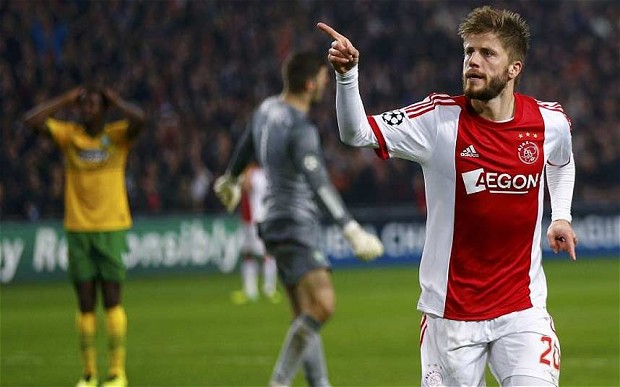
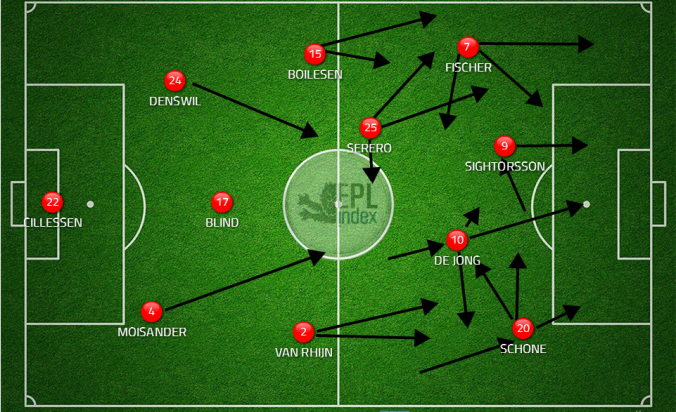
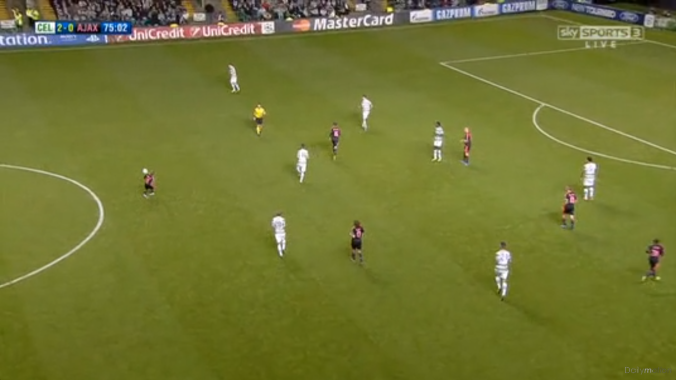
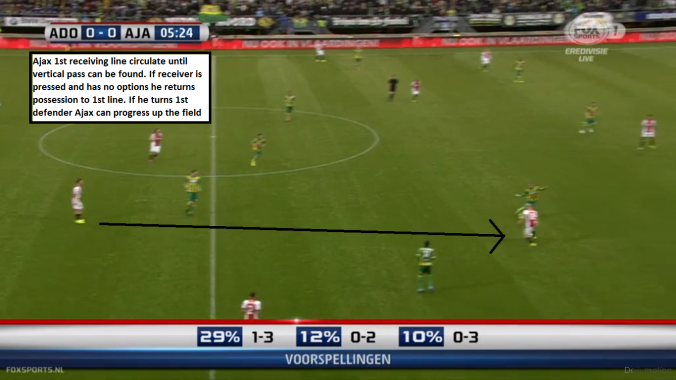
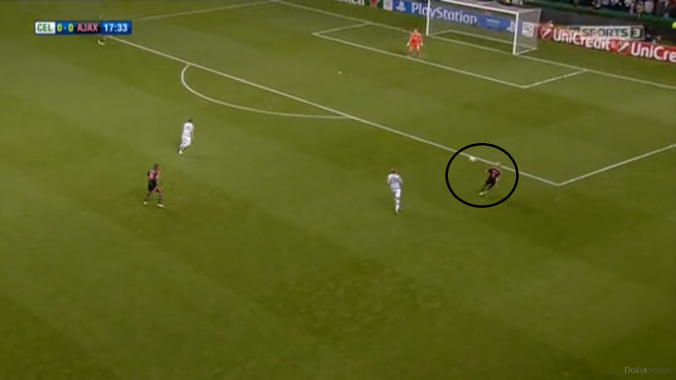
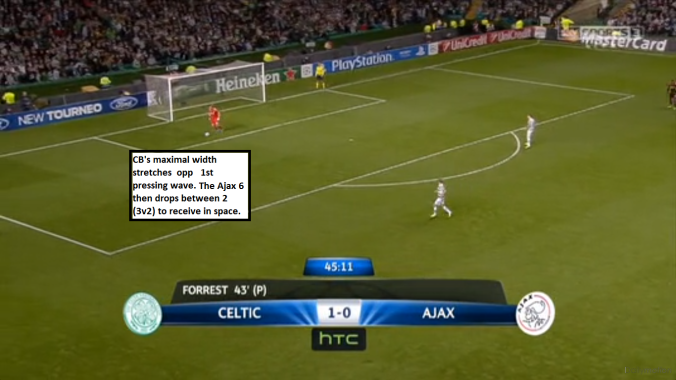
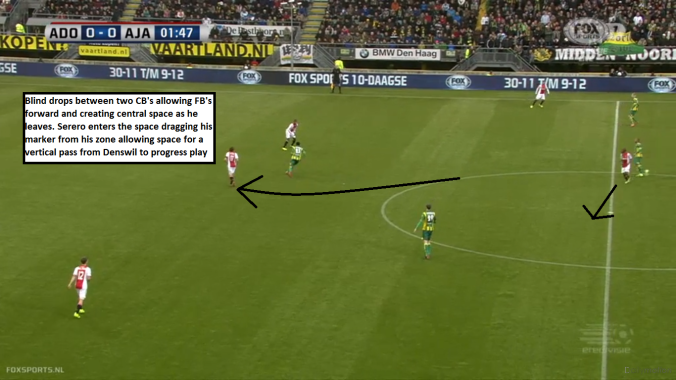
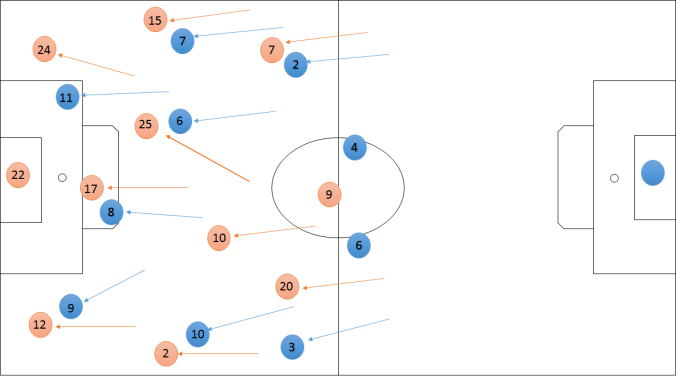
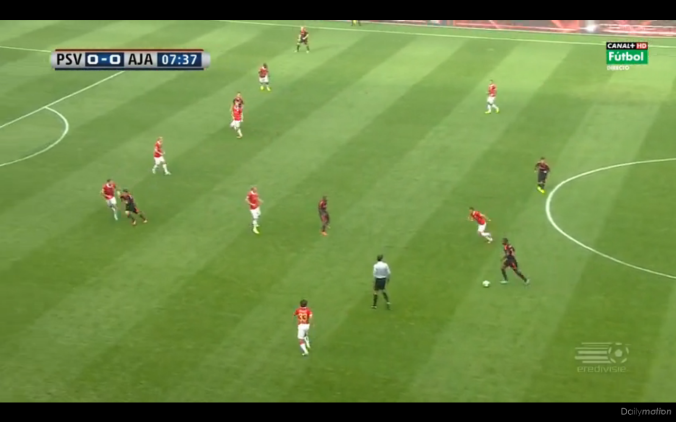
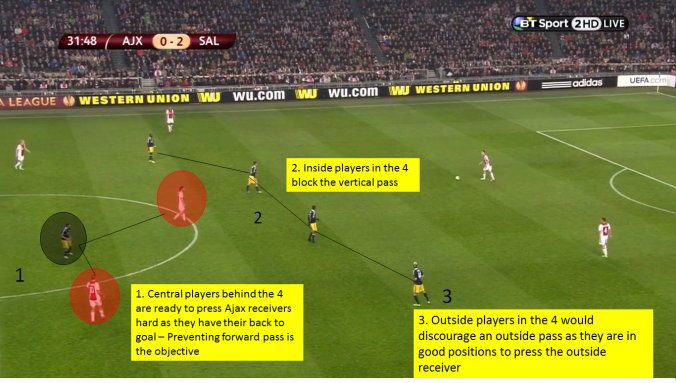
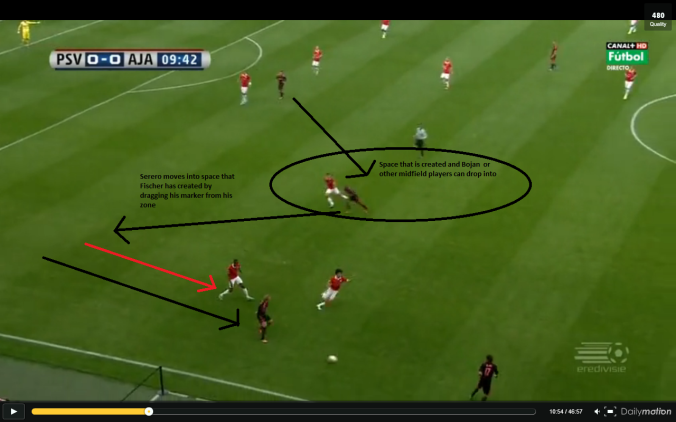
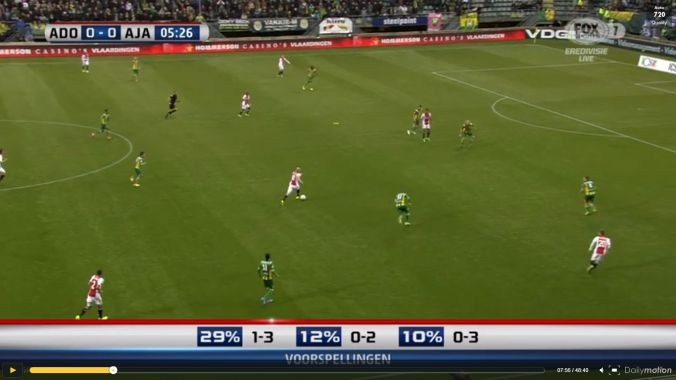
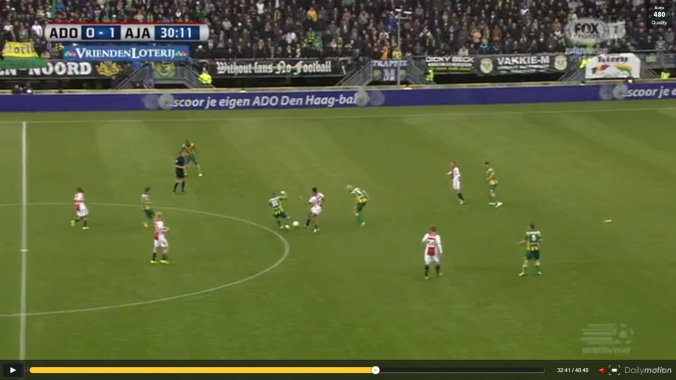
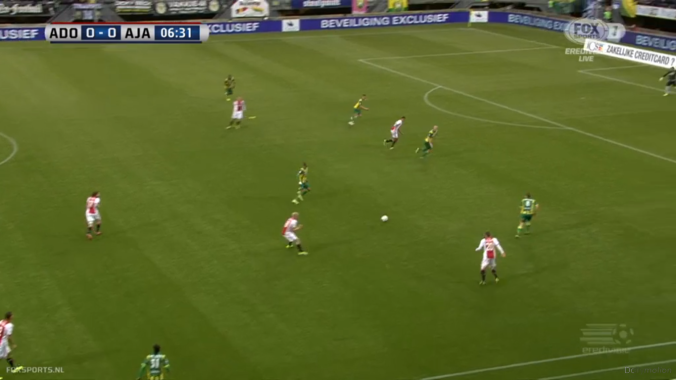
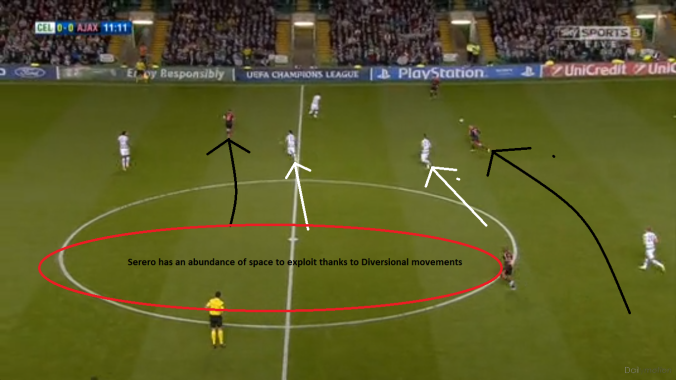
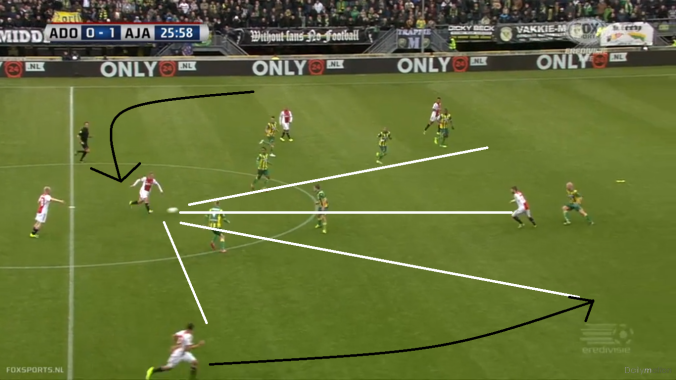
How closely would you say this resembles the methods used with Total Football, which was obviously born at Ajax in the 70’s. For me, it seems very similar. I will now be watching Ajax closely and I hope De Boer achieves his dreams of making Ajax a top European side again. Good article.
Pingback: Frank de Boer - Page 13